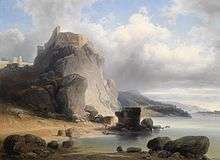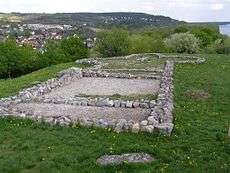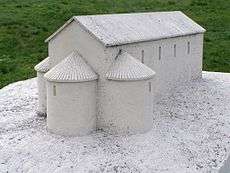Devín Castle
| Devín Castle Devínsky hrad | |
|---|---|
|
Bratislava Slovakia | |
|
The ruins of Devín Castle | |
| Type | Castle |
| Site information | |
| Controlled by | Great Moravia, Kingdom of Hungary, Czechoslovakia, Slovakia |
| Open to the public | nonstop, opening hours apply to the museum |
| Condition | Ruins (partially reconstructed) |
| Site history | |
| Built |
864 – 15th century Last fortifications built in the 17th century |
| Events |
Notable events in the castle's life:
|
Devín Castle (Slovak: hrad Devín [ˈɦrad ˈɟeʋiːn][1] or Devínsky hrad [ˈɟeʋiːnski ˈɦrat], Hungarian: Dévényi vár, German: Burg Theben) is a castle in Devín, which is a borough of Bratislava, the capital of Slovakia.
Description
Owing to its strategic position at the confluence of the Danube and Morava rivers, the cliff (elevation 212 meters) was an ideal place for a fort. Its owner could control the important trade route along the Danube as well as one branch of the Amber Road. That is why the site has been settled since the Neolithic and fortified since the Bronze and Iron Age. Later, both the Celts and the Romans built strong fortresses there.
The castle stands just inside Slovak territory on the frontier between Slovakia and Austria. The border runs from west to east along the Morava River and subsequently the Danube. Prior to 1989, the Iron Curtain between the Eastern Bloc and the West ran just in front of the castle. Although the castle was open to the public, the area surrounding it constituted a restricted military zone, and was heavily fortified with watchtowers and barbed wire. After the Velvet Revolution the area was demilitarised.
The most photogenic part of the castle is the tiny watchtower, known as the Maiden Tower.[2] Separated from the main castle, it balances perilously on a lone rock and has spawned countless legends concerning imprisoned lovelorn daughters leaping to their deaths.
Inside, the castle is a sprawling landscape of walls, staircases, open courtyards and gardens in various states of repair. They are all, however, made readily accessible by a continuing restoration and archaeological project conducted since the borough of Devín was reclaimed from Nazi Germany which had annexed it shortly before World War II.
Etymology
The name of the castle is probably derived from the old Indo-European/Proto-Slavic stem deiv- with apophony doiv- related to light and visual perception. Devín, Divín, Devinka, Divino, Dzivín and similar Slavic names can be interpreted as watchtowers or observation points.[3] The same root related to vision can be found also in the word div (evil spirit) thus meaning "the place of evil spirits". Less probable, but a popular explanation is a derivation from the old Slavic word deva (girl). In this case, "devin grad" means "castle of the girl".[4]
History




Devín castle belongs to the oldest castles in Slovakia. The castle likely is first mentioned in written sources in 864, when Louis the German besieged Prince Rastislav in one of the frequent wars between the Franks and Great Moravia respectively in the "castle of Dowina". On the other hand, the identification of Dowina with Devín Castle has been under debate[5] based both on alleged linguistic arguments and the absence of convincing archaeologic evidence.[6]
During the Great Moravian period, Devín was the center of a larger agglomeration. Its defensive role was enstrengthen by smaller hill forts on Devínska Kobyla (Na pieskach, Nad lomom). A pre-romanesque church was built on the castle approximately between 850 and 863/870.[7] Its rare style is closest to churches from the Dalmatia and Noricum, from the areas with a persisting tradition of late antique and Byzantine architecture.[8] The interior of the church was decorated with frescoes painted by colors originated (according to chemical analysis) in northern Italy.[9][10] Two styluses discovered by later research can indicate administrative or education work of the local priests. Along with other artifacts, six graves dated to the Great Moravian era were found near the church and are attributed to members of a retinue of the local ruler and their family members.[11]

In the 13th century, a stone castle was built to protect the western frontier of the Hungarian Kingdom whose existence was documented in 1271 and a reference to a castelanus de Devin appeared in 1326. Between 1301 and 1323, the castle (together with Bratislava/Pressburg County) was held by the Dukes of Austria who granted it to Otto von Tellesbrunn. In 1323, the dukes transferred Pozsony County back to King Charles I of Hungary and Devín Castle became the possession of the heads (ispáns) of the county. In 1385, the castle was occupied by Margrave Jobst of Moravia who held it until 1390 when King Sigismund of Hungary redeemed it and gave it to duke Stibor of Stiboricz. After that, the king mortgaged Devín Castle to an Austrian knight, Lessel Hering who transferred the castle to Nicholas II Garay (the Palatine of the Kingdom) in 1414. Around 1444, King Frederick IV of Germany occupied the castle but he granted it to Ladislaus Garai already in 1450.
A palace was added in the 15th century. Fortification was reinforced during wars against the Ottoman Empire. The Castle was never taken, but after the Hungarian Kingdom joined the Habsburg Monarchy and the Ottomans were finally defeated, it ceased to be an important border fortress and was no longer used by the military. Stephen Báthory got the castle by the king as a donation. But according to Stephen Báthory was Keglević the owner of the castle. Keglević pawned the castle for 40,000 guilders to the Palocsai family and spent the money. In 1609, Matthias II confirmed that Keglević still was the owner of the castle, but Keglević did not have the money to take the castle out of pledge from the Palocsai family. Nearly 100 years later in 1635 Palatine Pál Pálffy took the castle out of pledge from the Palocsai family.[12] The last owners of the Devín Castle were the Counts of the Pálffy family. Only in 1809, after the Siege of Pressburg, was the castle (still considered a threat) destroyed by the retreating forces of Napoleon I of France. Napoleon and Leopold Pálffy negotiated then and they both agreed that Vienna is supplied with products by Pálffy.[13]
Since the 19th century as its history inspired several Romantic poets, followers of Ľudovít Štúr, Devín has become an important national symbol for the Slovaks. It featured both on the reverse of the former 500 Czechoslovak koruna banknote and the 50 Halierov coin of the Slovak currency.
The Hungarians regarded it as the western gateway of the Kingdom of Hungary. The Hungarian poet Endre Ady used it as a symbol of modernism and Westernization in his poem I am the Son of Gog and Magog:
By Verecke's ancient route I came,
In my ear ancient Magyar songs still blaze,
Am I free to break through at Dévény,
With modern songs fit for modern days?— Endre Ady: I am the Son of Gog and Magog[14]
Some parts of the castle have been reconstructed in the 20th century and the castle hosts an interesting museum. Archaeological works at the site have revealed the remains of a Roman tower dating from the 1st century AD and evidence of a prehistoric settlement.[15]
See also
References
- ↑ In isolation, hrad is pronounced [ˈɦrat].
- ↑
- ↑ Ondruš 2010, pp. 205-206.
- ↑ Ondruš 2010, p. 206.
- ↑ Kristó, Gyula (editor) (1994). Korai Magyar Történeti Lexikon (9-14. század). Budapest: Akadémiai Kiadó. p. 553. ISBN 963-05-6722-9.
- ↑ According to this theory the vowel "o" of Dowina cannot be explained from "e", and all the documented names of Devín contain a front vowel: e.g., Devín, Theben, Dévény (http://www.uni-bonn.de/~ntrunte/publikationen8.html#dowina_inhalt). However, such supposed derivation is not necessary (see etymology) and the castle and the village is known under various historical names: 864 – Dowina, 1288 – castrum de Dywen, 1326 – Thebyn, tebyn, 1332 – Dévén, 1434 – Dewen, Theben, 1455 – Teben, 1491 – Tebm, 1529 – Thewen, 1531 – Thebmern, 1550 – Theenfeld, Dewen, 1577 – Thoben, 1578 – Thaben, 1605 – Taber, 1651 – Deeben, 1659 - Doben, 1722 – devenium, 1773 – Divinum, Teeben, 1786 – Diwin, 1825 – Divenium. (http://www.muop.bratislava.sk/vismo/zobraz_dok.asp?id_org=600176&id_ktg=1034) .
- ↑ Illáš 2011, p. 17.
- ↑ Illáš 2011, pp. 11-12.
- ↑ Štefanovičová 1989, p. 115.
- ↑ Illáš 2011, p. 18.
- ↑ Turčan 2013, p. 23.
- ↑ Presburg und seine Umgebung, C.F. Wigand, 1865.
- ↑ The History of the Rise, Progress, and Overthrow of Napoleon Bonaparte: With a Summary Account of the Circumstances which Paved the Way to the French Revolution Together with a History of the Wars, page 650, Theophilus Camden, J. Stratford, 1814.
- ↑ László, Gyula (1996). The Magyars - Their Life and Civilisation. Corvina. p. 355. ISBN 963-13-4226-3.
- ↑ http://www.bratislava-city.sk/devin-castle-bratislava
Sources
- Illáš, Martin (2011). "Predrománsky kostol na Devíne" [The Pre-romanesque Church on Devín] (PDF) (in Slovak).
- Ondruš, Šimon (2000). Odtajnené trezory slov I. (in Slovak). Martin: Vydavateľstvo Matice slovenskej. ISBN 80-7090-530-1.
- Turčan, Vladimír (2013). Veľkomoravské hradiská (in Slovak). Bratislava: DAJAMA. ISBN 978-80-8136-013-8.
- Štefanovičová, Tatiana (1989). Osudy starých Slovanov [Fate of the Ancient Slavs] (in Slovak). Osveta.
- Engel, Pál: Magyarország világi archontológiája (1301–1457) (The Temporal Archontology of Hungary (1301-1457)); História - MTA Történettudományi Intézete, 1996, Budapest; ISBN 963-8312-43-2.
External links
| Wikimedia Commons has media related to Devín Castle. |
- Short description of Devín Castle
- The Archontology of Great Moravia and the Serbian Moravia – the Sources
- Defending Bratislava at Devin - Spectacular Slovakia
- History, pictures, and google map of Devín Castle
- A video tour round the castle
Coordinates: 48°10′25″N 16°58′42″E / 48.17361°N 16.97833°E
